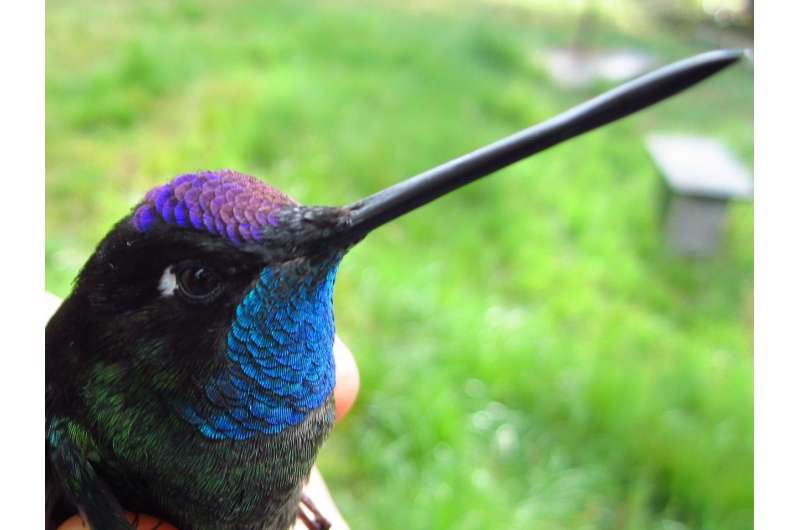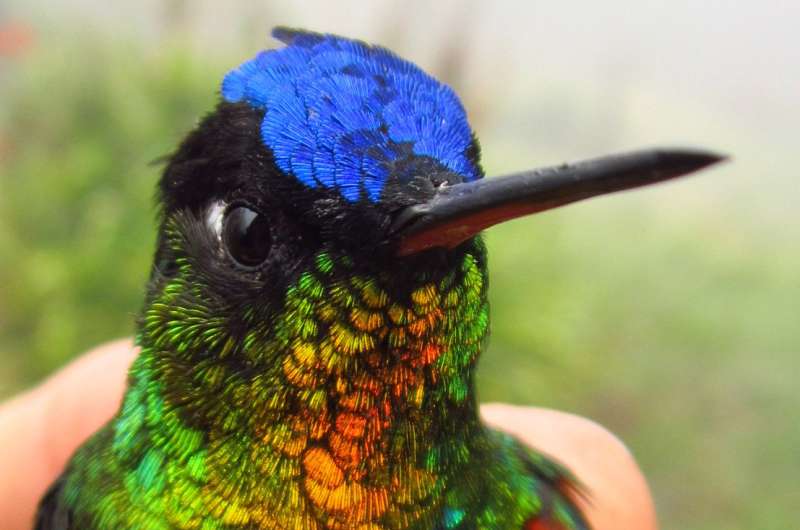Evolution—and skill—help hefty hummingbirds stay spry

Evolved differences in muscle power and wing size—along with a touch of skill—govern hummingbirds' inflight agility, according to new research in Science.
The findings by University of British Columbia biologists show that larger species of hummingbirds, despite their increased mass, are able to adapt to outmaneuver smaller species.
"Studies of bats, birds and other animals show that increases in body mass can have a detrimental effect on many aspects of flight," says Roslyn Dakin, co-lead author on the study.
"But with hummingbirds, the correlated evolution of increased wing size and muscle mass helps larger species compensate for their greater body masses."
Dakin, study co-lead Paolo Segre and senior author Douglas Altshuler used sophisticated video capture and a novel geometrical framework to determine how maneuverability relates to differences in physiology—notoriously difficult relationships to quantify.
They found that acceleration is primarily driven by a bird's muscle capacity, whereas maneuvers involving rotations are driven primarily by wing size. But skill also plays a role.
"The hummingbirds tend to play to their strengths, especially with complex moves," says Altshuler. "For example, species that have the ability to power through turns tend to use more arcing trajectories, and they shy away from performing turns in which they decelerate to turn on a dime."

The researchers captured over 200 individual hummingbirds from 25 Central and South American species. Computer vision technology developed by co-author Andrew Straw at the University of Freiburg in Germany enabled the researchers to record inflight maneuvers with precision.
"We recorded over 330,000 maneuvers, including many repeated maneuvers for each bird," says Segre, now a postdoctoral researcher at Stanford University.
"Capturing that much data was a challenge. Our first field site was at a biological reserve deep in the Peruvian Amazon, an area with many species of hummingbirds, but only accessible by boat. We ran our computers and cameras using solar panels and generators in a thatched hut with strategically placed rain buckets!"

Hummingbirds vary greatly in body mass and wing shape—and many species have evolved to perform at high elevation where the air density is low. That variety offers researchers a great opportunity to study how traits relate to agility in flight, says Dakin.
"There are a lot of questions we can look into now. How do these differences impact their ability to survive and find mates? If maneuverability is an advantage to some species, how do others get by with less agility? What is it about their lifestyle that differs?"

More information: R. Dakin el al., "Morphology, muscle capacity, skill, and maneuvering ability in hummingbirds," Science (2018). science.sciencemag.org/cgi/doi … 1126/science.aao7104
Journal information: Science
Provided by University of British Columbia
















